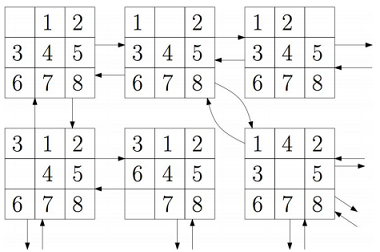Reference no: EM132169923
Assignment -
Consider the vertically averaged momentum equations for 2-D horizontal flow below (derived from 3-D equations):

These 2-D equations can be laterally averaged from bank-to-bank to provide the 1-D hydrodynamic model (St. Venant Equations) shown below (these are the governing equations from the EPA DYNHYD model) with the added assumption that atmospheric pressure gradients and longitudinal density gradients do not result in longitudinal accelerations and Coriolis forces are negligible:
Longitudinal Momentum:
∂u/∂t = -u ∂u/∂x - g ∂h/∂x - (gn2/R4/3)u|u| + CDρau2a/Rρw
where -
CD: drag coefficient
n: Manning's friction factor
h: water depth
R: hydraulic radius
ua: wind speed at 10 m elevation
ρa: air density
ρw: water density
u: water velocity
g: acceleration due to gravity
Continuity:
∂h/∂t = -1/B ∂Q/∂x
where -
Q: uA
A: cross-sectional area
Note that Manning's equation for steady-uniform flow is
u = - R2/3/n(∂h/∂x)0.5
Vreugdenhil (1989) in Chapter 16 presents the following equations as the 1-D simplified form of the St. Venant equations (linearized):
∂u/∂t + g ∂h/∂x + ru = 0
∂h/∂t + a ∂u/∂x = 0
where r = [∂u/∂x + cf/a |u|] using cf as a Darcy-Weisbach friction factor from Vreugdenhil (1989). Comparing this to the DYNHYD equation above, this r term would be in terms of the Manning friction factor, n, and the hydraulic radius, R: r = [∂u/∂x + g n2/R4/3 |u|].
The above continuity equation is for a prismatic channel where B does not change with x or depth.
For a varying width with distance for a rectangular channel (hence no variation in B over time) and using Q (a conservative form) rather than u, the continuity equation is
∂h/∂t = - 1/B ∂Q/∂x
The momentum equation in Q (conservation form of the governing equations) would then be
∂Q/∂t + ∂/∂x (Q2/A) + gA ∂h/∂x + rQ = 0
Where r = [Bcf/A2|Q|] = [gn2/AR4/3|Q|].
Wind speed shear on the water surface has been neglected.
Tasks -
1. Write codes to solve the above equations using the (1) Explicit leap-frog scheme solving
∂h/∂t = - 1/B ∂Q/∂x
∂Q/∂t + ∂/∂x(Q2/A) = gA ∂h/∂x + rQ = 0
and the (2) implicit C-N scheme (for this scheme assume the convective acceleration terms can be neglected) solving
∂h/∂t = - 1/B ∂Q/∂x
∂Q/∂t + gA ∂h/∂x + rQ = 0
Comment briefly on the solution schemes and their accuracy using analyses and discussion from the handout notes based on neglecting the convective acceleration terms and constant channel width (in other words, do not do any theoretical work here, merely draw comments from the handout from Vreugdenhil, 1989, Chapter 16). Note also that the CN implicit scheme can still work with the non-linear convective acceleration terms by using the value of Q at the earlier time step. [Write out schemes and comment on accuracy].
2. Use both schemes to solve the following problem:
(i) Assume the following:
a. The domain length goes from head of tide to the ocean boundary and is 100 km.
b. Channel width varies linearly from a width of 500 m increasing to 1000 m from the head of tide to the ocean boundary. The width though is assumed constant at all depths at each cross-section (a rectangular cross-section). Hence, B = 500 + (500/100,000) x.
c. Channel depth varies linearly from 10 m at the head of tide to 20 m depth at the ocean boundary. Hence the depth to mean sea level is a = 10 + (10/100,000) x.
d. The tidal boundary condition has an amplitude of 1 m and a period (T) of 12.4 hrs, i.e., the tide elevation above the datum (mean sea level) can be represented as h = amplitude sin 2πt/T.
e. The flow rate in the river at the head of tide is constant at 2000 m3/s.
f. The initial condition is that Q(x, t = 0) = 0 and h(x, t = 0) = 0.
g. Manning's friction factor is 0.035.
Predict dynamic water level, flow rate, and velocity. Run the model for 1 week. Compare predictions of water level, velocities and flow at x = 70 km for the last 24-hour period between the 2 schemes (that is plot water level, velocity and flow over time for 24 hours at x = 70 km).
Can you comment on the differences between the 2 schemes?
(ii) Now add another model branch - solved independently as the Willamette River. This branch intersects the Columbia River at 20 km from the head of tide (upstream flow boundary). How would you connect the branches together? Assume a constant flow rate of 250 m3/s from the Willamette branch and that it has a flat bottom with an average depth of 7 m, width of 200 m, and length of 30 km. Solve using only the explicit leap frog scheme. Plot water levels, flow rates, and velocities at x=15 km in the Willamette River grid also for the last 24-hour period. Does the water level and flow rate change in the mainstem when you add the Willamette branch?
3. Now add the conservation form of the transport equation using results from your explicit leap frog scheme model with the Willamette River.
∂c/∂t = 1/A ∂cuA/∂x = 1/A ∂/∂x[ADL ∂c/∂x] - kc
subject to the initial condition that C(x, t = 0) = 0 and BC that
(1) C(x = 0, t) = Co(t) and (2) ∂c/∂x|x=L,t = 0|
Where DL = 10 m2/s, Co = 0 mg/l, k = 0.1 day-1
Use the explicit Quickest Numerical scheme for this equation. [Note: be careful in setting up the scheme since it is dependent on the velocity direction!] Add a sudden spill of a toxic pollutant at x=50 km on day 2. The spill mass is 1000 kg. Plot the concentration over time at x=70 km. [Show scheme, implement scheme and show predictions]
References - Vreugdenhil, C. B. (1989) Computational Hydraulics, Springer-Verlag, NY.
Attachment:- Assignment File.rar